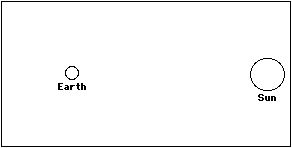
CCCC Moon's Orbit/Phases/Eclipses
As it orbits around the Earth, the Moon varies in speed thanks to Kepler’s Laws. Sometimes it moves a bit faster in its orbit; sometimes a bit slower. Imagine that during a time when the Moon is moving very quickly in its orbit, the Earth, Moon and Sun happen to line up perfectly so that those of us on Earth witness a solar eclipse.
a) Will we see a total solar eclipse (in which the Sun is completely obscured by the Moon) or will we see an annular eclipse (in which a thin ring, or annulus, of the Sun is still visible because the Moon doesn’t completely cover up the Sun)?
b) Explain your answer using a few sentences and/or a simple diagram.
--
It is sunset. As the Sun sets over the Western horizon, you recall that tonight the Moon happens to be in its New phase.
a) Draw an overhead view of the Earth-Moon-Sun system, showing where the New Moon is located relative to the Earth and the Sun.
b) Can you see a New Moon at midnight from Fort Worth? (Simple yes or no is fine)
--
The zodiacal constellations are thought to be special because they lie close to the Ecliptic, the apparent path of the Sun in the sky over the course of a year.
a) How often would you expect to see the Full Moon among the zodiacal constellations? (Pick one: Every Full Moon? Once a year? Never?)
b) Draw a diagram to help explain your answer.
--
During an annular solar eclipse, the Moon does not completely cover the Sun on the sky. The Moon is too small and so leaves a thin ring (also called an “annulus”) of the Sun visible. Kepler’s Laws tell us that the Moon’s orbital velocity around the Earth is not constant. Sometimes it moves faster, sometimes slower.
a) During an annular eclipse, would you expect the Moon to be moving faster in its orbit or slower in its orbit than normal?
b) Explain your answer to (a) in a few sentences. You may want to draw a small diagram to help.
--
This evening, the first quarter moon will set at roughly midnight, about six hours after sunset. Use this single observation to disprove the hypothesis that lunar phases are caused by the shadow of the Earth on the Moon. You may want to use a diagram to help your explanation, but a diagram by itself will not suffice as an answer.
--
Near the beginning of this month, the moon was in its “new” phase (almost completely dark), and it set at almost the same time as the Sun. Use this single observation to disprove the hypothesis that lunar phases are caused by the shadow of the Earth on the Moon. You may want to use a diagram to help your explanation, but a diagram by itself will not suffice as an answer.
--
During a crescent moon phase, a line from the Earth to the Moon makes a 45 degree angle above or below (doesn’t matter which for this question) a line from the Earth to the Sun.
a) (4 pts) On the diagram below, a view of the solar system from above, draw in the location of the Moon during the crescent phase described above.
b) (8 pts) Draw in the location of the Earth’s shadow on the diagram, and then explain in a sentence or two why the phases of the moon cannot possibly be caused by the shadow of the Earth.

--
Below is a drawing of the Earth and the Moon as they orbit the Sun together. A “sidereal” month is the time it takes in order for the Moon to return to its original position as seen from Earth with respect to the distant background of stars. A “solar” month is the time it takes in order for the Moon to return to its original position as seen from Earth with respect to the Sun.
a) (4 pts) Which is shorter? (sidereal, solar, same length, can’t determine)
b) (8 pts) Explain your answer. You may find it easier to explain if you simply add to the diagram given below, but a diagram itself is not a sufficient answer.
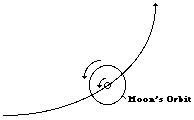
--
A solar eclipse occurs when the shadow of the Moon falls on the Earth during its new phase. However, eclipses do not happen every month.
a) (6 pts) In the diagram below, which represents a side view of our solar system, draw in a side view of the Moon’s orbit during a time when the Moon appears in its new phase but we do not see a solar eclipse.
b) (6 pts) Draw in the location of the Moon’s shadow, and then explain in a sentence or two why we don’t see a lunar eclipse during this particular new phase.
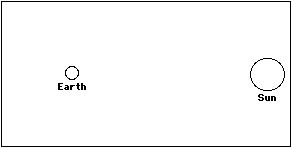
--
About three hours before the Sun sets, you notice the Moon just appearing over the Eastern horizon. Thus, as the Sun is setting in the West, the Moon is located at an altitude of about 45 degrees above the Eastern horizon.
a) (6 pts) In what phase is the Moon? Draw a simple Sun-Earth-Moon diagram to help explain your answer.
b) (6 pts) If you were standing on the Moon at this time, in what phase would the Earth appear to be? No explanation is necessary for this part.
--
Explain the observational evidence that falsifies the theory that lunar phases are caused by the Earth’s shadow falling on the Moon.
--
Suppose you’re part of a lunar colony in the distant future. On the diagram below (a view of the Earth-Moon system from above the plane of the ecliptic), imagine the Earth, as seen from your location on the Moon, is in its “new” phase. No explanations needed for this problem.
a) (2 pts) Draw in the location of the Moon.
b) (2 pts) In what phase is the Moon at this time as seen from Earth?
c) (2 pts) As seen from the Moon, does the Earth undergo phase changes over the course of a month (yes/no/can’t determine)?
d) (2 pts) As seen from the Moon, does the Earth’s location in the sky change over the course of a month (yes/no/can’t determine)?
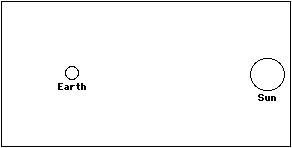
--
For the following problem, we consider observations of the Full moon...
a) (8 pts) Often people see the full moon on the horizon or the full moon close to overhead. Which would you expect to have a larger angular size, the full moon on the horizon, or the full moon directly overhead? Justify your answer using simple mathematics (I am *not* asking here about simple observational tests you could perform to check your answer).
b) (6 pts) During Full moon, the Sun, Earth and Moon are aligned in such a way that the Sun and the Moon are on nearly opposite sides of the sky from one another. Viewed from above the Earth's north pole, the situation looks almost like there should be a lunar eclipse every month, yet there isn't. Explain why we don't have eclipses every month.
--
Suppose you’re part of a lunar colony in the distant future. On the diagram below (a view of the Earth-Moon system from above the plane of the ecliptic), imagine the Earth (as seen from your location on the Moon) is in its “full” phase. No explanations needed for this problem.
a) (4 pts) Draw in the location of the Moon.
b) (4 pts) In what phase is the Moon at this time as seen from Earth?
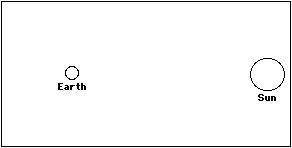
To an astronaut on the surface of the Moon, the Earth appears to remain stationary in the sky. During the course of a month, it undergoes “phases” just like the Moon does as viewed from Earth.
a) (6 pts) On the diagram below, draw in the location of the Moon during “full Earth” phase.

b) (6 pts) We know that Mars’ orbital path around the Sun lies outside that of Earth. Is it possible for Mars and “full Earth” to be near one another on the sky? Explain!
--
We know that that the same face of the Moon always points at the Earth as the Moon completes an orbit around the Earth every 28 days. No explanations necessary for this problem, though you may show any simple calculations if you wish for possible partial credit if your reasoning is correct.
a) (2 pts) Does the Moon rotate on its axis? (yes/no)
b) (3 pts) Suppose from the surface of the Moon, you look directly overhead at your zenith point and see a solar eclipse in progress (the Earth and Sun are directly lined up over your head). How much time will pass between now and sunset on the Moon as seen from your location?
c) (3 pts) From the time of this Earth-caused solar eclipse, how much time will pass between now and Earthset on the Moon as seen from your location?
--
When you go outside and see the full moon coming up above the horizon, it is often orange and apparently very large compared to what it looks like when high up in the sky. Suppose Jim Bob were to tell you, "Yeah, the Moon looks larger right after it rises because it's closer to the Earth."
a) (5 pts) Describe a simple experiment you could perform to prove that the angular size of the Moon does not change as the Moon moves across the sky.
b) (9 pts) Explain what scientific reasoning you would use to convince Jim Bob that the Moon is *not* significantly closer to the Earth (or at least, your location on the Earth) when it rises compared to when it is high in the sky.
--
Someone tells you that the reason the Moon shows phases over the course of the month is because of the shadow of the Earth falling on the Moon. Name and explain two pieces of evidence you would provide to that person to contradict his statement. I am not asking here why the phases of the Moon actually occur, just asking for you to disprove the statement.
--
Use the diagram below to help answer the following questions (no explanation needed). Just circle the correct choices:
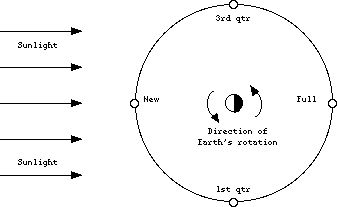
a) (3 pts) What time of day does new moon rise? (sunrise, noon, sunset, midnight)
b) (3 pts) What time of day does full moon rise? (sunrise, noon, sunset, midnight)
c) (4 pts) What time of day is the new moon overhead? (sunrise, noon, sunset, midnight)
d) (4 pts) What time of day does the 3rd qtr moon set? (sunrise, noon, sunset, midnight)
--
Other possible questions using diagram from previous question...
What time of day does 1st qtr moon rise? (sunrise, noon, sunset, midnight)
What time of day is the full moon overhead? (sunrise, noon, sunset, midnight)
What time of day does the new moon set? (sunrise, noon, sunset, midnight)
What time of day is the 1st qtr moon overhead? (sunrise, noon, sunset, midnight)
What time of day does 3rd qtr moon rise? (sunrise, noon, sunset, midnight)
What time of day does the full moon set? (sunrise, noon, sunset, midnight)
--
Explain why some solar eclipses are total while others are annular. As part of your answer, draw a simple diagram representing each case to show specifically what is different about the two situations.
--
Someone tells you that the angular size of the Moon when it is close to the horizon is larger than the angular size of the Moon when it is high overhead.
a) (10 pts) Given the fact that the Earth-Moon distance doesn't change significantly in a few hours (the time it takes for the Moon to travel from the horizon to a point overhead), explain with the help of a simple diagram why this statement cannot be true.
b) (4 pts) Explain a simple experiment you could perform to disprove this person's statement about the angular size of the Moon.
--
Imagine Earth in the distant future. Due to forces we will talk about in the next few lectures, millions of years from now, the Moon will be further from the Earth than it is today, by as much as 20-40% further away.
a) (4 pts) Will the orbital speed of the Moon be different in the future compared to now? If so, will it be larger or smaller in the future? Whether you think it will change or not, justify your answer with a brief sentence of explanation.
b) (5 pts) Will the angular size of the Moon as seen from Earth be different in the future compared to now? If so, will it be larger or smaller in the future? Whether you think it will change or not, justify your answer with a brief sentence of explanation.
c) (4 pts) Suppose we have a solar eclipse sometime in the future. Will this eclipse more likely be annular or total? Or would there be about an equal chance of either? Explain.
--
Solar eclipses are a rare phenomenon, caused by the Moon blocking our view of the Sun from the Earth. They only happen when the Moon is in its new phase, but solar eclipses don't happen every time there is a New Moon.
a) (7 pts) Explain why solar eclipses are relatively rare instead of occuring every time there is a new moon phase.
b) (7 pts) When the moon and the sun are perfectly lined up, sometimes a ring of sunlight is still visible around the disk of the moon. This is known as an annular eclipse. Use the equation of angular size to help explain why some eclipses are annular and some total.
--
Name and explain two different lines of evidence that prove the phases of the Moon are not caused by the shadow of the Earth falling on the Moon.
--
Suppose you are observing the Moon's motion during its full phase. When the full Moon first rises above the horizon, you measure its angular size with some device, and you repeat the measurement again when it is overhead, confirming that the angular size hasn't changed.
a) (4 pts) At what time of day must you make these measurements? In other words, when does the full Moon rise, and when is it overhead? Choose between sunrise, noon, sunset and midnight. No explanation needed.
full Moon rises at _______________
full Moon overhead at __________________
b) (10 pts) Use the equation of angular size to help explain mathematically how we know without making any measurements that the angular size of the moon cannot be significantly different on the horizon (and definitely not larger) compared to overhead. A simple diagram may help but is not sufficient by itself as an answer.
--
Imagine Earth in the distant past. Due to forces we will talk about in the next few lectures, millions of years ago, the Moon was closer to the Earth than it is today, by as much as 20-40% closer.
a) (4 pts) Was the orbital speed of the Moon different in the past compared to now? If so, was it larger or smaller in the past? Whether you think it changed or not, justify your answer with a brief sentence of explanation.
b) (5 pts) Was the angular size of the Moon as seen from Earth different in the past compared to now? If so, was it larger or smaller in the past? Whether you think it changed or not, justify your answer with a brief sentence of explanation.
c) (4 pts) Suppose we had a solar eclipse sometime in the past. Was this eclipse more likely to be annular or total? Or was there be about an equal chance of either? Explain.
--
How often does the sun rise from a given location on the Moon? How often does the Earth rise from a given location on the moon? Use a diagram to help explain each answer.